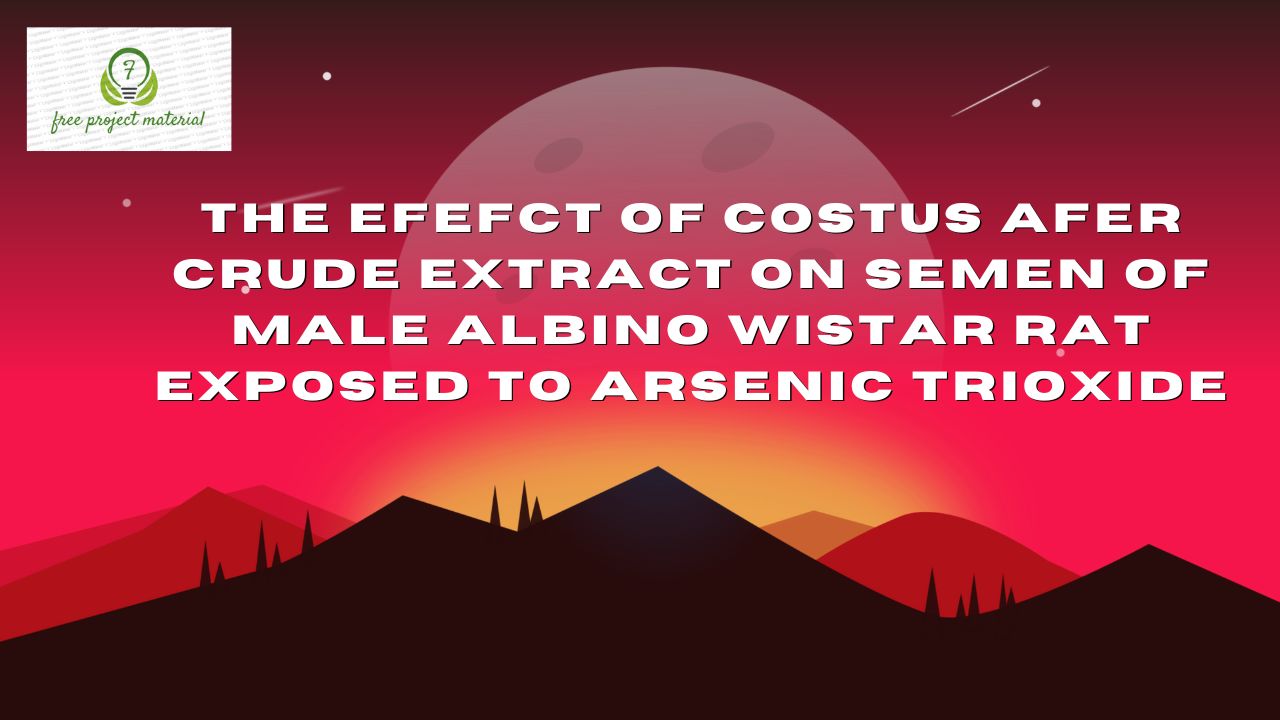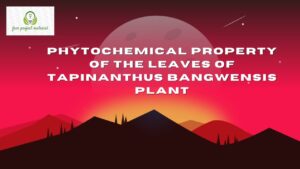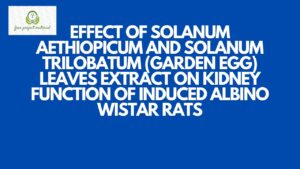ABSTRACT
The aim of this study was to examine the effect of Costus afer extract on semen of male albino wistar rats exposed to arsenic trioxide. Twenty (20) albino wistar rats weighing between 80 – 160g were randomly assigned five (5) groups of four rats each. Group 1, 2 and 3 served as the treatment groups and were exposed to 30% of LD50 of arsenic trioxide 4 every four (4) days for 14 days. Thereafter, they were administered with 0.2ml, 0.4ml and 0.6ml/kg body weight of the crude extract of Costus afer respectively every other days for 14 days. Group 4 served as the negative control and was exposed to 30% of LD50 of Arsenic trioxide every four (4) days for 14 days. Group 5 served as the normal control and was given only the normal rat pellet and distilled water. All animals were allowed free access to feed and water. At the end of the 28 days, the rats were sacrificed and the semen sample was collected for analysis. The result of the analysis revealed a significant (P<0.05) decrease in percentage motile sperm, active sperm, concentration and normal sperm while an increase in non-motile, sluggish and bent-neck sperms in group 1 and 4 when compared to group 5. and a non-significant (P>0.05) increase in curve sperm of group 4 and 1 when compared to the normal control. But on the administration of crude extract of Costus afer, the percentage motile sperm, active sperm, concentration and normal sperms non-significantly (P>0.05) increased while the percentage non motile, sluggish, bent neck and curve sperms non significantly decrease in group 1, 2 and 3 when compared to group 4 but there was no significant difference between the treatments group 2 and 3 when compared to the normal control. This result indicated that arsenic trioxide causes deleterious effect on the sperm cells, although the crude extract of Costus afer was able offer non-significant improvement in the sperm cells. This therefore suggest that the use of higher concentration of the crude extract could offer a more significant improvement in the sperm cells. Hence, the use of Costus afer as herbal medicine for boosting male fertility is recommended and finally further studies is recommended on the effect of Costus afer on rats exposed to Arsenic trioxide with a higher dose of the extract than those use in this study.
TABLE OF CONTENTS
TITLE PAGE- – – – – – – – – i
CERTIFICATION- – – – – – – – ii
DEDICATION- – – – – – – – – iii
ACKNOWLEDGEMENTS- – – – – – – iv
ABSTRACT- – – – – – – – – v
TABLE OF CONTENTS- – – – – – – vi-viii
CHAPTER ONE: INTRODUCTION
1.1 Background of the Study- – – – – – 1
1.2 Aim and Objective of the study- – – – – 5
1.3 Scope and Limitation of the Study- – – – – 6
1.4 Definition of terms- – – – – – – 6
CHAPTER TWO: LITERATURE REVIEW
2.1 Description of Costus afer– – – – – – 8
2.2 Botanical and Ecological Distribution of the plant- – – 11
2.3 Nutritional and Phytochemical Composition of
Costus afer– – – – – – – – 13
2.4 Pharmacological Activities of Costus afer– – – – 14
2.4.1 Protective ability against kidney, liver, heart,
testicle and mitochondrial damage- – – – – 14
2.4.2 Analgesic and Anti-Inflammatory Effects- – – – 18
2.4.3 CNS Depressant Activity- – – – – – 22
2.4.4 Antiparasitic and Antibacterial property- – – – 23
2.4.5 Pancreatic protection, Antidiabetic property and
hypolipidemic effect- – – – – – – 24
2.5 Toxicity of Costus afer – – – – – – – 26
2.6 Physiology of Semen- – – – – – – 28
2.7 Effect of Arsenic on Semen- – – – – – 33
2.8 Alleviating agents of Arsenic toxicity on male reproductive system- – 36
2.9 Semen Analysis- – – – – – – – 38
CHAPTER THREE: MATERIALS AND METHODS
3.1 Materials- – – – – – – – – 44
3.2 Methods- – – – – – – – – 46
3.2.1 Sample Collection and Preparation- – – – – 46
3.2.2 Experimental Design and Treatment- – – – – 46
3.2.3 Collection of Semen- – – – – – – 48
3.2.4 Semen Analysis- – – – – – – – 49
3.3 Statistical Analysis- – – – – – – 51
CHAPTER FOUR: RESULTS AND DISCUSSION
4.1 Results- – – – – – – – – 52
4.2 Discussion- – – – – – – – – 55
CHAPTER FIVE: CONCLUSION AND RECOMMENDATIONS
5.1 Conclusion- – – – – – – – – 65
5.2 Recommendations- – – – – – – 65
References-
CHAPTER ONE: INTRODUCTION
1.1 Background of the Study
Plants represent a major part of the therapeutic ingredients in almost all systems of medical science. Herbal therapy in Africa is an age-long practice. Men’s continuous reliance on herbs for therapeutic and nutritional benefits cannot be overemphasized. Herbs and herbal products, or herbal supplements are all forms of plant materials used as complementary or alternative medicines throughout the world.
Costus afer (bush cane, ginger lily) is a widespread tropical plant commonly found in shabby forest and river-banks of West Africa (Iwu, 1993).
The use of plants as medicine by people dates as far back as the beginning of civilization. Plants are important sources of many biologically active compounds. Plants used in traditional medicine provide an interesting and still largely unemployed source for the development of new drugs (Cos et al.,2006). Globally about 85% of all medications for health care are derived from plants. (Fransworth, 2000). Medicinal plants have various effects on living systems. Some are sedatives, analgesics, antipyretics, cardioprotectives, antibacterials, antivirals and antiprotozoals.
However, this study focuses on remedies for fertility. Conversely, a number of herbs used in the management of reproductive disorders were Sphenocetrum jolyanum for loss of libido in men, Telferia occidentalis and Aframomum melegueta for low sperm counts. (Okoli et al., 2007).
Costus afer, of the family Costaceae, a perennial rhizomatous herb, is commonly called “spiral ginger”, „ginger lily‟ or „bush cane (Aweke, 2007). “eti” by the Isokos and Urhobos and „monkey sugarcane‟ in Warri and most parts of Delta State, Nigeria. Most rural dwellers use this medicinal plant to treat upper respiratory tract and gastro-intestinal infections (Barnish and Samai, 1992), and gonorrhoea1 (Noumi and Eloumou, 2011), and syphilis (Arhoghro et al., 2014). Costus afer is rich in phytochemical constituents. The leaves have been shown to contain an abundance of alkaloids and flavonoids and trace amounts of saponins, tannins and glycosides (Arhogro et al.,2014). Flavonoids and alkaloids have been reported to be antibacterial, antiviral, anti-inflammatory and antineoplastic (Miller, 1996).
Arsenic (As) a sulfhydryl-reactive metalloid is a chief ecological toxicant formed by the flaming of arsenic-polluted coal and glass industrialized (Owens, & Katz, 2005). The use of arsenic as herbicides, fungicides and rodenticides is also the important source of contamination. This metal is an extensive environmental waste with mutagenic, teratogenic and carcinogenic effects. Arsenic has also been reported to pollute sea environments, freshwater environments and groundwater. Contamination of drinking water with arsenic has become a noteworthy distress in Bangladesh, West Bengal, India, China, Mongolia, Nepal, Cambodia, Myanmar, Afghanistan, DPR Korea and Pakistan (Owen and Katz, 2005).
Chronic use of arsenic may cause severe health-destructive effects including melanosis, hyperkeratosis, lung disease, peripheral vascular disease (black foot disease) and gangrene (Das et al.,2009). Arsenic is a well-known human carcinogen and is capable of provoking malformations in male reproductive system (Chang et al.,2007; Das, Ghosh, Manna, Sinha, & Parames, 2009). Sodium arsenite-induced reproductive toxicity is responsible for the decrease in testes and accessory sex organ weights. In animals, arsenic induces the spermato toxicity (Pan et al.,2004) by reducing the weight of testes and accessory sex organs as well as the synthesis of male reproductive hormone especially testosterone. Some authors also reported that arsenic may induce gonad dysfunction through declined testosterone synthesis, apoptosis and necrosis.
Many studies have reported that arsenic accumulates in testes, epididymis, seminal vesicle and prostate glands (Pant et al.,2004).
Environmental toxicants seem to be responsible for causing the infertility in male through decreasing the quality of semen during the last decade (Sarkar et al.,2000). Arsenic diminished epididymal sperm count, viability and motility and normal morphology (Pant et al.,2004). Reduction in the level of luteinizing hormone (LH), follicle-stimulating hormone (FSH) and testosterone and also huge deterioration of the germ cells in testicular tissue are reported to be an explanation for arsenic toxicity. Sodium arsenite has originated to have an inhibitory end product on the action of testicular steroidogenic enzyme D5-3b- hydroxysteroid dehydrogenase (D5-3b-HSD) and 17β-hydroxysteroid dehydrogenase (17β-HSD) and to reduce the weight of testes and accessory sex glands (Sarkar et al.,2003) in rats. High concentration of arsenic may restrain the sensitivity of gonadotroph cells to GnRH as well as gonadotropin secretion by uplifting plasma levels of glucocorticoids. These factors ultimately lead to the development of gonad toxicity (Sarkar et al.,2003).
1.2 Aim and Objective of the Study
Aim
The aim of this research project is to determine the effect of Costus afer on semen of male albino wistar rat exposed to Arsenic trioxide.
Objective
- To determine the effect of crude extract of Costus afer on the motility of the semen of the male wistar rats exposed to Arsenic trioxide.
- To determine the effect of crude extract of Costus afer on the concentration of the semen of the male albino wistar rat exposed to Arsenic trioxide.
- To determine the effect of crude extract of Costus afer on the morphology of the semen of the male albino wistar rat exposed to Arsenic trioxide.
1.3 Scope and Limitation of the Study
The design of this research project is to investigate and determine the effect of crude extract of Costus afer on the semen of male albino wistar rats exposed to Arsenic trioxide. And due to the shortness of research time, lack of adequate facilities and financial constraint, this research project was limited.
1.4 Definition of terms
Sperm Motility: Sperm motility refers to the ability of the sperm to move efficiently.
Sperm Concentration: This refers to the number of sperm per unit volume of semen.
Sperm Morphology: This refers to the size, shape and appearance of man’s sperm which when abnormal can decrease fertility and make it more difficult to fertilize the woman’s egg.
Semen: Semen is the thick fluid that comes out from men’s penis when they ejaculate during sexual activity.
Arsenic trioxide: Sold under the brand arisenox among other, is an inorganic compound and medication, with the chemical formula AS2O3.


